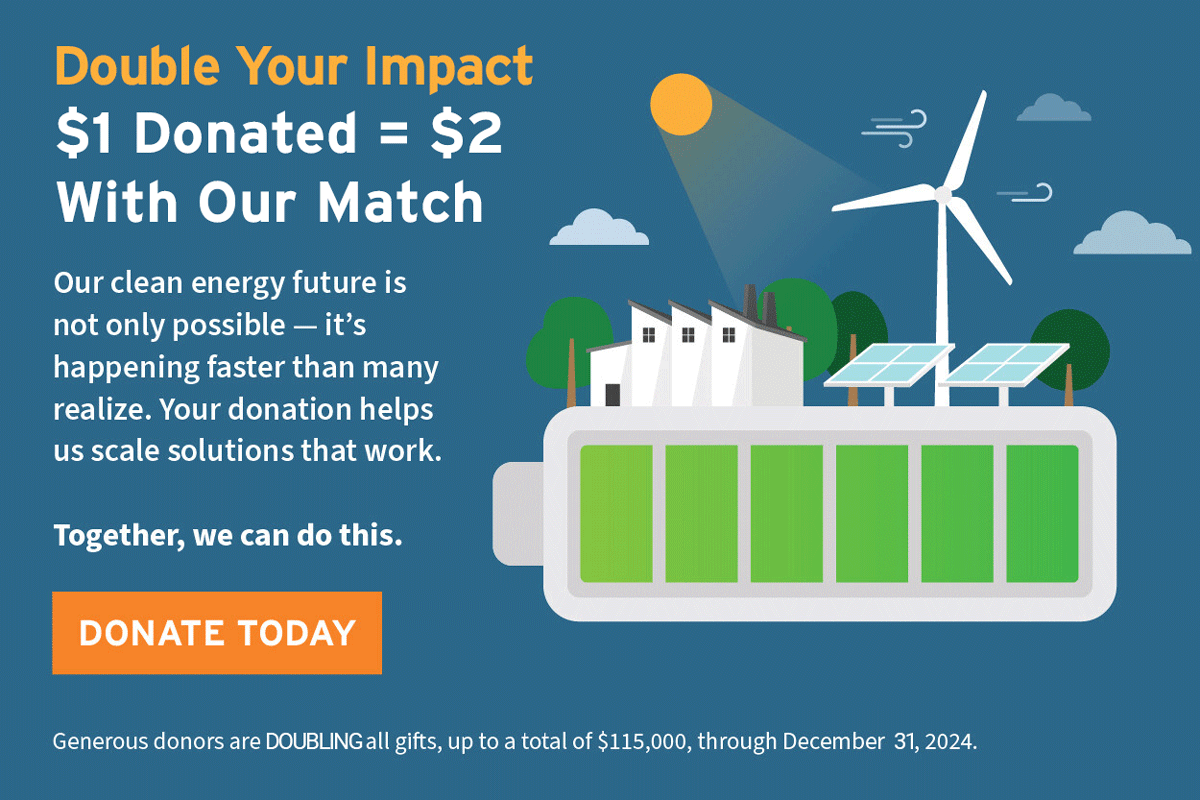
Fighting Climate Change on the Home Front
New Products and New Policy Can Make Decarbonizing Home Energy Use Easy
What if you could help combat climate change from your home without lifting a finger?
Imagine if you could ask your utility, with the click of a button, to supply your home with 100 percent carbon-free energy. Imagine if the appliances in your home could automatically reduce the emissions from the electricity that powered them, without you even noticing. Imagine if you could safely ride out extreme weather in your home without extreme energy use. And finally, imagine if you could do all this affordably and easily.
If everyone could do this, it would go a long way toward meeting the United States’ climate policy targets. And importantly, it would improve health, especially in communities hardest hit by fossil fuel pollution. Committing to a transition in our homes at this scale could also open up widespread availability of key technologies and programs, unlocking equitable access to clean energy for all communities.
Today, RMI released a blueprint for how regulators, policymakers, utilities, and solutions providers can support every American in bringing clean energy home. The report, independently authored by RMI with funding from Google, also provides an assessment of a service—Google’s Nest Renew—in the context of this opportunity to support ambitious US climate goals through consumer choice and action.
It’s Not Easy Being Clean
Imagination aside, decarbonizing home energy use today is not always easy. Making informed decisions to reduce household emissions is complex and often costly, requiring that we take in dozens of sources of technical and unfamiliar information, use it to make nuanced decisions, and then pay upfront for many of the solutions. And because the best strategies depend on countless factors (geography, home age and type, etc.), solutions are fragmented.
The Barriers We Encountered Trying to Decarbonize Our Homes
The authors of this blog have experienced these challenges firsthand. Lauren is a renter in a pre-war building in New York City. The demand response program in which she enrolled her window air conditioners was discontinued a year later. She struggled to predict how enrolling in a community solar program or green retailer would impact her electricity bill. And she enrolled her parents, homeowners in California, in a green tariff program that was supposed to save them money. Yet they received unexpected notifications that their rate would increase their bill moving forward within a few months.
Mark is a homeowner in Colorado. To promote clean energy development in his community, he enrolled in a utility green tariff program—but his utility unsubscribed him without warning or recourse when he moved. In his new house, Mark navigated a maze of local and utility incentives, contractors, and self-produced spreadsheet analyses to prioritize an electrification upgrade—which, even now that it is successfully completed, remains incompatible with other smart energy technologies in his home.
In short, even for motivated and informed households like ours, there is no “easy button” for decarbonizing home energy use (see sidebar). And furthermore, the legacy of utility regulation and policy in this country has meant that most utilities and other businesses lack the agency, incentives, or capabilities to help guide people through the complex steps required for material carbon savings.
What most utilities and other businesses offer for most Americans are products and programs that touch only a small fraction of emissions from our homes, leaving millions of tons of CO2 on the table even as evidence mounts that we need to drastically accelerate emissions reductions.
Building the “Easy Button”
What if there were a better way? RMI’s work over nearly 40 years has often focused on how businesses—supported by policy—can identify and develop new markets for carbon-free energy. Likewise, we feel businesses can play a role in driving innovation to address households’ adoption barriers to clean energy.
With this context in mind, RMI accepted an invitation from Google to independently assess the potential climate benefits of Google’s newly announced service, Nest Renew. Nest Renew will be free to join and enables customers to choose to manage energy use based on emissions or local electricity prices. It will also offer a platform to educate households about their energy use and identify changes that can support lowering household emissions.
For Premium subscribers, Google will match a home’s estimated fossil electricity use to renewable energy credits that support generation from wind and solar in the United States. In addition, it will provide an opportunity to support nonprofits focused on working in communities on equitable clean energy deployment.
From a climate perspective, Nest Renew has the potential to support its subscribers to make a material impact on carbon emissions associated with their household energy use. The Premium service could support reducing CO2 emissions by approximately 30 percent for an average household. At scale, this is significant.
If 10 million households participate (approximately the same number of utility customers who participate in utility demand response programs today), a service like Nest Renew could get us closer to our climate targets. We found that the renewable energy and demand-side management supported by such a service could address approximately 7 percent of the gap between today’s level of household emissions and the 50 percent reduction from 2005 levels needed to reach President Biden’s overall policy target. That’s the equivalent of powering about 50 million EVs with a cleaner grid each year, as opposed to today’s fossil-fuel heavy grid.
Unlocking the Full Opportunity Requires Structural Changes
Addressing 7 percent of US households’ emissions gap toward policy targets is a worthy goal but is insufficient by itself to address the scale of the climate crisis. A service like Nest Renew could amplify its emissions savings impact if it enables more people to take more-material action toward decarbonizing household energy use.
RMI examined additional emissions savings from features that could be incorporated into future iterations of services or products like Nest Renew. These include support for siting new carbon-free energy resources where they will have the highest carbon impact, enabling demand flexibility from more devices and appliances, and supporting electrification investments for homes and personal vehicles.
A product of that scope could address and dramatically reduce nearly every source of household energy-related carbon emissions. Delivering those savings to approximately 50 million homes across the United States could fully close the gap between today’s emissions and a 50 percent reduction target by 2030.
Exhibit 1: Opportunity to achieve climate policy goals with a service like Nest Renew
Achieving adoption at such massive scale of products that address household emissions with such a broad scope is a daunting but solvable problem. To make it happen, solutions providers need to offer solutions that are:
- Targeted to the needs of specific homes and people, for example by using relevant, customer-specific data to tailor options;
- Affordable for households across a range of income levels, for example by aggregating resources across households to provide valuable services to the grid and thus reduce net costs to customers;
- Simple for people to understand and prioritize, for example by automating shifts in energy use; and
- Integrated across different energy uses within the home and with the broader grid, for example by ensuring interoperability across devices and vendors.
Such solutions can accelerate to their full potential with a few key shifts in policy and regulation. To enable Americans to seamlessly bring clean energy home and contribute to meeting ambitious climate targets, utilities, their regulators, and policymakers have an opportunity to:
- Adjust utility incentives and processes to maximize integration of demand-side resources and ensure utilities have business motivations and tools to accelerate, not slow, household decarbonization opportunities;
- Align customer incentives, programs, and rates with decarbonization objectives and household benefits to streamline the options available to customers and solutions providers and make climate-aligned options more affordable and attractive; and
- Enable data access and transparency to provide customers and solutions providers with the information they need to develop and monetize grid-integrated clean energy solutions for homes.
Both solutions providers and the policymakers, regulators, and utilities that shape the markets in which they operate must act, quickly and in coordination, to let Americans effectively prioritize clean energy choices for their homes. Delaying action will result in a significant missed opportunity for customers themselves to accelerate the energy transition and realize its benefits where they matter most—in our homes.
